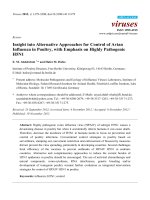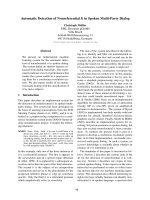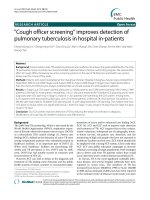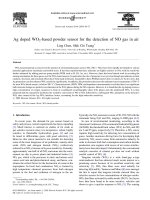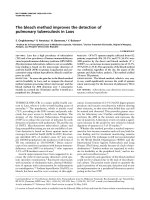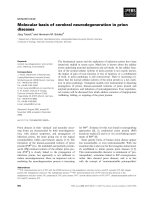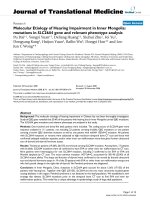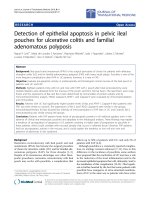Molecular detection of avian mycoplasmas in poultry affected with respiratory infections in Haryana (India)
Bạn đang xem bản rút gọn của tài liệu. Xem và tải ngay bản đầy đủ của tài liệu tại đây (262.49 KB, 8 trang )
Int.J.Curr.Microbiol.App.Sci (2017) 6(6): 2155-2162
International Journal of Current Microbiology and Applied Sciences
ISSN: 2319-7706 Volume 6 Number 6 (2017) pp. 2155-2162
Journal homepage:
Original Research Article
/>
Molecular Detection of Avian Mycoplasmas in Poultry Affected with
Respiratory Infections in Haryana (India)
Piyush Tomar1*, Y. Singh1, N.K. Mahajan1, Naresh Jindal1 and Mahavir Singh2
1
Department of Veterinary Public Health and Epidemiology, College of Veterinary Sciences
Lala Lajpat Rai University of Veterinary and Animal Sciences (LUVAS), Hisar, India
2
College Central Laboratory, College of Veterinary Sciences, Lala Lajpat Rai University of
Veterinary and Animal Sciences (LUVAS), Hisar, India
*Corresponding author
ABSTRACT
Keywords
Mycoplasma
gallisepticum,
Mycoplasma
synoviae, PCR.
Article Info
Accepted:
26 May 2017
Available Online:
10 June 2017
Mycoplasma gallisepticum (MG) and Mycoplasma synoviae (MS) are the most
economically significant Mycoplasma pathogen of poultry. The objective of this study was
molecular detection of avian Mycoplasmas in poultry affected with respiratory infections
in Haryana (India). In this study 92 pooled tissue samples including trachea, lungs and air
sacs were collected from 92 different poultry flocks affected with respiratory infections
and were undergone mycoplasmological examination by Polymerase chain reaction (PCR).
Four sets of primers including a universal primer (16S rRNA) for genus Mycoplasma, two
primers for M. gallisepticum (16S rRNA gene and 16S-23S rRNA IGSR) and one for M.
synoviae (16S rRNA gene) were employed for amplification of genes of all the 92 DNA
samples extracted from tissue samples. Direct detection of avian Mycoplasma in tissue
specimen by PCR using 16S rRNA universal primers for genus Mycoplasma followed by
MG and MS specific PCR revealed, 34/92(36.9%) Mycoplasma, 25/92(27%) MG and 2/92
(2.1%) MS. This study demonstrated the high prevalence of MG infection in commercial
Broilers farms of Haryana. Therefore, the high prevalence and wide distribution of MG
infection warrants immediate attention and preventive strategies to minimize economic
impact of MG infection. The present study suggests that the PCR assays performed for
MG and MS provide a simple, quick and precise tool to specifically detect these organisms
from the field samples which are always found to be complicated by other pathogens.
Introduction
Haryana is a small state of India but it is the
5th largest in poultry population (Livestock
census, 2012). There are many poultry
pathogens which are responsible for huge
economic losses to poultry industry through
respiratory infections such as Mycoplasma, E.
coli, Newcastle disease virus, Infectious
bronchitis virus. The mycoplasmas do not
have cell wall and are smallest self-replicating
prokaryotes. There are mainly two
Mycoplasma species which are pathogenic in
nature viz. M. gallisepticum (MG) and M.
synoviae (MS). In chickens M. gallisepticum
causes Chronic Respiratory Disease and
usually show loss of appetite, dullness,
depression, tendency to huddle together, poor
growth, emaciation, respiratory rales,
tracheitis, air sacculitis, coughing, sneezing,
2155
Int.J.Curr.Microbiol.App.Sci (2017) 6(6): 2155-2162
open mouth breathing, nasal discharges and
dyspnea (Gupta et al., 2009). Conjunctivitis
with frothy ocular exudate is common in
turkeys and occurs occasionally in chickens.
In broilers due to MG infection, there is a
reduction in weight gain of up to 20% to 30%,
a 10% to 20% decrease in food conversion
efficiency, a 5% to 10% mortality rate and
10% to 20% of carcasses are condemned at
the processing plant (Kleven, 1990). In
breeders and layers, the disease causes a 10%
to 20% decrease in egg production (nearly 16
fewer eggs per hen) and a 5% to 10% increase
in embryo mortality (Kleven, 1990). Another
serologically distinct Mycoplasma associated
with infectious synovitis of poultry was first
reported by (Chalquest and Fabricant, 1960)
and had been named M. synoviae by (Olson et
al., 1964). Generally the preliminary
detection of flock for MG and MS is done by
serological
tests
namely
slide/plate
agglutination test and/or ELISA and
confirmation can be done by culture and/ or
molecular identification (Ramadass et al.,
2006; Zhang et al., 2011). Several workers
have described the use of conventional PCR
in detecting avian mycoplasmas directly from
clinical samples such as nasal swab, trachea
and air sac (Ramadass et al., 2006; Bibank et
al., 2013). PCR has some advantage over
cultural detection as it can detect the
pathogens in dead organism also and also
rapid, inexpensive and sensitive method.
Therefore, the present study was carried out
to detect the Mycoplasma infection in poultry
affected with respiratory infection by PCR.
sacs were collected post necropsy from
chicken affected with respiratory infections
and immediately processed for PCR
examination. These 92 pooled samples
represented 92 different poultry flock.
Genus and species specific PCR
Samples
DNA was extracted directly from tissue
samples collected from various poultry flocks
using the DNA extraction mini kit (Qiagen,
Germany) following the manufacturer’s
recommendations. Polymerase chain reaction
assay was carried out on extracted DNA
samples from 92 pooled tissue samples to
amplify the 16S rRNA gene fragment specific
to Genus Mycoplasma, 16S rRNA and 16S23S rRNA fragments specific to M.
gallisepticum and 16S rRNA specific to M.
synoviae species as per protocols described by
(Zhi et al., 2010; OIE, 2008; Raviv et al.,
2007) respectively. The primer specific to
Genus
Mycoplasma
was;
F5’GGCGAATGGGTGAGTAACACG3’ and
R- 5’CGGATAACGCTTGCGACCTATG3’
and size of amplified product was 461bp (Zhi
et al., 2010). Two sets of primers were used
to amplify MG DNA. First is 16S rRNA, F5’GAGCTAATCTGTAAAGTTGGTC3’ R5’GCTTCCTTGCGGTTAGCAAC3’
and
yielded 185 bp product (OIE, 2008). Second
primer was IGSR (16S to 23S rRNA) with
sequence, F-5’GTAGGGCCGGTGATTGGA
GTTA3’ and R-5’CCCGTAGCATTTCGCA
GGTTTG3’ and yielded a product size of 812
bp (Raviv et al., 2007). Species specific
primer for MS, 16S rRNA F- 5’GAGAAG
CAAAATAGTGATATCA3’ and R-5’CAGT
CGTCTCCGAAGTTAAC AA3’ with 207 bp
product size OIE (2008).
Pooled tissue samples were collected from 92
poultry flocks which were brought from
different parts of Haryana for disease
investigation during July 2015 to January
2016 in the Department. Ninety two pooled
tissue samples including trachea, lungs and air
S-6 serotype antigen (Salsbury laboratories,
U.K.) of MG and M. synoviae antigen (Soleil,
Biovac Animal Health, France) were used as
positive control to carry out PCR specific to
genus Mycoplasma, MG and MS. At the time
of each run, DNA extracted from standard
Materials and Methods
2156
Int.J.Curr.Microbiol.App.Sci (2017) 6(6): 2155-2162
strains of MG and MS were used as positive
controls. Beside, 100 bp ladder was used as
marker DNA in each run. Amplification
conditions were optimised for each of the
primers separately. The PCR reaction mix of
25 µl was optimum included 0.5 µl of each
primer (10 µM), 12.5 µl of Master Mix
(HotstarTaq master mix Qiagen, 2X), 10.5 µl
of Nuclease free water (NFW) and 1 µl of
template DNA. Amplification of 16S rRNA
specific to Genus Mycoplasma, species MG
and MS were done using protocol as
described by Zhi et al., (2010) and OIE
(2008) respectively with initial denaturation
of DNA at 94°C for 15 min. It was followed
by 40 cycles of denaturation, annealing and
extension at 94°C for 30 sec, 55°C for 30 sec
and 72°C for 1 min respectively and final
extension was carried out at 72°C for 5 min.
For the second primer of MG (16S-23S
rRNA) amplification of species specific
DNA for M. gallisepticum was done as per
method described by (Raviv et al., 2007).
The PCR amplification was achieved with
initial denaturation of DNA at 94°C for 15
min. It was followed by 30 cycles of
denaturation, annealing and extension at 94°C
for 20 sec, 55°C for 30 sec and 72°C for 1
min respectively, and final extension was
carried out at 72°C for 5 min. The amplified
PCR products were analysed by agarose gel
electrophoresis using 2% agarose containing
0.5 µg/ml ethidium bromide in tris-acetate
EDTA (TAE) buffer and visualized by gel
documentation system (Alphaimager, HP), as
per the method of (Sambrooke et al., 1989).
The size of the amplified product was
ascertained by comparison with standard
DNA marker (100 bp DNA ladder, Thermo
scientific, USA).
Results and Discussion
Our findings show, amongst ninety two DNA
samples, 34 (36.9%) to be positive for genus
Mycoplasma and the product size of amplicon
was recorded 461 bp (Figure 1). The DNA
from these 34 Mycoplasma on further
amplification with MG and MS specific primer
revealed, 25 (27%) M. gallisepticum and 2
(2.1%) M. synoviae. The product size of
amplicon was recorded 185 bp for MG and
207 bp for MS (Figures 2 and 3). Thirty four
DNA of mycoplasmas amplified using IGSR
primer for MG also revealed 25 (27%) MG.
However the product size of amplicon was
recorded 812 bp (Figure 4).
In this study we only sampled one flock per
farm which could result in an underestimation
of the prevalence if biosecurity measures are
well applied in farms. However, we assumed,
based on a study by Feberwee et al., (2005)
which demonstrated that the reproduction
ratio R0 of M. gallisepticum is higher than 1,
that once there is an infection in a flock it will
spread quickly within the whole flock. As
evident from above, samples subjected to
genus specific PCR, 34 (36.9%) were found
positive for Mycoplasma genus specific PCR.
In concurrence with present study, (Qasem et
al., 2015) reported the higher prevalence
(48%) of Mollicutes by PCR from poultry
flock affected with respiratory infection.
However in India, (Sankar, 2012) reported
24% genus Mycoplasma using genus specific
PCR from poultry tissue affected with avian
mycoplasmosis. This high prevalence of
genus Mycoplasma was due to detection of
both
pathogenic
and
non-pathogenic
commensal mycoplasmas which could not be
differentiated using genus specific PCR.
Tissue specimens subjected to genus specific
PCR using were followed by MG and MS
specific PCRs. We used two sets of primers
for amplification of MG DNA targeting 16S
rRNA gene and IGSR (16S-23S rRNA). It is
known that two phylogenetically related avian
mycoplsamas, MG and Mycoplasma imitans,
have very similar 16S rRNA genes and that
the primers targeted this gene give similar
products. Due to the fact 16S rRNA gene has
2157
Int.J.Curr.Microbiol.App.Sci (2017) 6(6): 2155-2162
two copies on the MG and MS genomes, the
PCR targeted 16S rRNA have higher
sensitivity. The genome sequencing analysis
of different avian mycoplasmas revealed that
there is a region, the IGSR located between
16S and 23S rRNA, which has greater
variation within different species and strains
than in the 16S rRNA gene. Due to the above
facts about we have selected both these type
of primer for the amplification of MG DNA.
Higher prevelance of MG (27%) was
recorded by PCR using the 16S rRNA and
IGSR primers showing 25 samples positive.
Our findings appear to correspond with other
studies that found 32% prevalence of MG
(Buim et al., 2009) and (Singh, 2013).
Likewise, (Rauf et al., 2013) also reported
higher prevalence of MG (68%) by PCR from
poultry affected with respiratory syndrome.
This high prevalence may be explained by the
increase of vertical transmission due to the
lack of surveillance programme in breeder
poultry flocks of India which results in spread
of MG infection from breeder hens to their
offspring.
Fig.1 Agarose gel electrophoresis of PCR products of DNA extracted from tissue samples
depicting the presence of Mycoplasma species, as evident by a band of 461 bp using genus
specific universal primer (16S rRNA)
Lane M = 100 bp marker, Lane 1-7 = Field samples
Lane 8 = Negative control, Lane 9 = Positive control
2158
Int.J.Curr.Microbiol.App.Sci (2017) 6(6): 2155-2162
Fig.2 Agarose gel electrophoresis of PCR products of DNA extracted from tissue samples
depicting the presence of M. gallisepticum (MG), as evident by a band of 185 bp using species
specific primer for MG (16S rRNA)
Lane M = 100 bp marker, Lane 1-14 = Field samples
Lane 15 = Negative control, Lane 16 = Positive control
Fig.3 Agarose gel electrophoresis of PCR products of DNA extracted from tissue depicting the
presence of M. synoviae (MS), as evident by a band of 207 bp using species specific primer for
MS (16S rRNA)
Lane M = 100 bp marker, Lane 1-14 = Field samples
Lane 15 = Negative control, Lane 16 = Positive control
2159
Int.J.Curr.Microbiol.App.Sci (2017) 6(6): 2155-2162
Fig.4 Agarose gel electrophoresis of PCR products of DNA extracted from tissue samples
depicting the presence of M. gallisepticum, as evident by a band of 812 bp using species specific
primer for MG (IGSR)
Lane M = 100 bp marker, Lane 1-14 = Field samples
Lane 15 = Negative control, Lane 16 = Positive control
MG prevalence in chickens has been reported
to be high in many countries with no control
strategy against MG (Gharaibeh and Al
Roussan, 2008). Whereas in India (Ramdass
et al., 2006) reported lower prevalence (3.4%)
of MG on direct detection by PCR from tissue
of poultry affected with respiratory infections
and 4% by (Michiels et al., 2016) from
poultry flocks affected with respiratory
infection in Belgium. This low prevalence can
be due to difference in sampling strategy,
surveillance programme, and season of
sample collection. In Belgium there is
reduction of vertical transmission due to the
mandatory surveillance programme in breeder
poultry flocks that aims to prevent and control
spread from breeder hens to their offspring
and protect national and international trade
markets (Michiels et al., 2016). Lower
prevalence of MS (2%) was recorded by PCR
using the 16S rRNA primer showing 2
samples positive. The results of present study
are comparable with 2% prevalence of MS as
reported by (Buim et al., 2009) and 0.8% by
(Saritha and Veeregowda, 2013). In contrary
(Ramdass et al., 2006) reported somewhat
higher prevalence of MS (6.4%) by PCR from
poultry affected with respiratory disease at
Chennai.
This study demonstrated the high prevalence
of MG infection in Commercial broilers farms
of Haryana. Therefore, the high prevalence
and wide distribution of MG infection
warrants immediate attention and preventive
strategies to minimize economic impact of
MG infection. The present study suggests that
the PCR assays performed for MG and MS
provide a simple, quick and precise tool to
specifically detect these organisms from the
field samples which are always found to be
complicated by other pathogens. One of the
benefits of PCR over cultural isolation of
avian Mycoplasma is that PCR is not
dependent on viable or structurally intact cells
and the presence of DNA in the tissues is
sufficient to yield a positive result. The PCR
2160
Int.J.Curr.Microbiol.App.Sci (2017) 6(6): 2155-2162
being more sensitive, specific and reliable test
can be applied for the early diagnosis of avian
mycoplasmosis in poultry flocks.
References
Bibank, F., Kalidari, G.A., Razmyar, J. and
Rad, M. 2013. Isolation of Mycoplasma
spp from broiler flocks with respiratory
syndrome in Mashhad, Iran. Iranian J
Vet. Sci. Tech., 5 (1): 11-18.
Buim, M.R., Mettifogo, E., Timenetsky, J.,
Kleven, S. and Ferreira, A.J.P. 2009.
Epidemiological survey on Mycoplasma
gallisepticum and M. synoviae by
multiplex PCR in commercial poultry1.
Pesq. Vet. Bras, 29(7):552-556.
Chalquest, R.R. and Fabricant, J. 1960.
Pleuropneumonia-like
organisms
associated with synovitis in fowl. Avian
Dis., 4: 515-39.
Feberwee, A., Mekkes, D.R., De Wit, J.J.,
Hartman, E.G. and Pijpers, A. 2005.
Comparison of culture, PCR and
different serologic tests for detection of
Mycoplasma
gallisepticum
and
Mycoplasma synoviae infections. Avian
Dis., 49, 260-268.
Gharaibeh, Saad, Laibinis, V., Wooten, R.,
Stabler, L., and N.F. 2011. Molecular
Characterization
of
Mycoplasma
gallisepticum isolates from Jordan.
Avian Dis., 55: 212–216.
Gupta, A., Ezzeldin, T. and Agrawal, P. 2009.
Mycoplasma
complicated
chronic
respiratory disease (CCRD): A review.
Published
on
06.10.2009
at
en.engormix.com.
Kleven, S.H. 1990. Summary of discussions
of avian mycoplasma team international
research program on comparative
Mycoplasmology, Hungary October 16–
20, 1989, Avian Pathology, 19:4, 795800
Livestock census 19th. 2012. Department of
Animal Husbandry, Dairying and
Fishing, Ministry of Agriculture.
Michiels, T., Welby, S., Vanrobaeys, M.,
Quinet, C., Rouffaer, L., Lens, L.,
Martel, A. and Butaye, P. 2016.
Prevalence
of
Mycoplasma
gallisepticum and Mycoplasma synoviae
in commercial poultry, racing pigeons
and wild birds in Belgium. Avian
Pathol., 45(2): 44-252.
OIE. 2008. Manual of Diagnostic tests and
Vaccines for Terrestrial Animals.
Chapter 2.3.5: Avian mycoplasmosis
(Mycoplasma
gallisepticum,
M.
synoviae), pp. 482-496
Olson, N.O., Kerr, K.M. and Campbell, A.
1964. Control of infectious synovitis 13.
The antigen study of three strains. Avian
Dis., 8: 209-14.
Qasem, J.A., Al-Mouqati, S.A., Al-Ali, E.M.
and Ben-Haji, A. 2015. Application of
Molecular and Serological Methods for
Rapid Detection of Mycoplasma
gallisepticum
Infection
(Avian
mycoplasmosis). Pak. J. Biol. Sci.,
18(2): 81-7.
Ramadass, Ananthi, R., Senthilkumar,
T.M.A.,
Venkatesh,
G.
and
Ramaswamy, V. 2006 Isolation and
characterization
of
Mycoplasma
gallisepticum and Mycoplasma synoviae
from poultry. Indian J. Anim. Sci., 76
(10): 796-798.
Rauf, M., Chaudhary, Z.I., Younus, M.,
Anjum, A.A., Ali, M.A., Ahmad, A.N.
and Khan, M.U.R. 2013. Identification
of M. gallisepticum by polymerase
chain reaction and conventional
diagnostics from White Leghorn layer
flocks. J. Anim. Plant Sci., 23 (2): 393397.
Raviv, Ziv, Callison, S.N., Ferguson-Noel,
Laibinis, V., Wooten, R and Kleven,
S.H.
2007.
The
Mycoplasma
gallisepticum
16S–23S
rRNA
Intergenic Spacer Region Sequence asa
Novel Tool for Epizootiological
2161
Int.J.Curr.Microbiol.App.Sci (2017) 6(6): 2155-2162
Studies. Avian dis., 51:555–560
Sambrook, J., Fritsch, E.F. and Maniatis.
1989. In: Molecular cloning, a
laboratory manual. Second edition. Cold
Spring Harbor Laboratory Press.
Sankar, S. 2012. Polymerase chain reaction
based detection of Mycoplasma
gallisepticum in chicken. Indian Vet. J.,
10: 5-8
Saritha, N.S. and Veeregowda, B.M. 2013.
Identification and characterization of
Mycoplasma synoviae from chicken by
Polymerase Chain Reaction (PCR).
Indian J. Vet. Res., 22 No.1:15-19
Singh, D. 2013. Molecular epidemiology of
infectious bronchitis, Newcastle disease
and Mycoplasma gallisepticum in
broilers in Haryana. Ph.D. thesis.
Department of Veterinary Public Health
and Epidemiology, LUVAS, Hisar.
Zhang, J, Guo, Y, HuS, B., Wang, X., Xiao,
Y., Gao, X., LiZ, L.M., Peng, F. and
Xu, Q. 2011. An adhesion molecule
based
colloidal
gold
immunochromatography assays trip for
rapidly and specifically detecting
chicken antibodies against Mycoplasma
gallisepticum. Res.Vet.Sci, 90(3): 379384.
Zhi, Yan, Mayhew, Amy, Seng, Natalie and
Takle, Garry. 2010. Validation of a
PCR method for the detection of
mycoplasmas according to European
Pharmacopoeia
section
2.6.7.
Biologicals, 38: 232–237.
How to cite this article:
Piyush Tomar, Y. Singh, N.K. Mahajan, Naresh Jindal and Mahavir Singh. 2017. Molecular
Detection of Avian Mycoplasmas in Poultry Affected with Respiratory Infections in Haryana
(India). Int.J.Curr.Microbiol.App.Sci. 6(6): 2155-2162.
doi: />
2162
